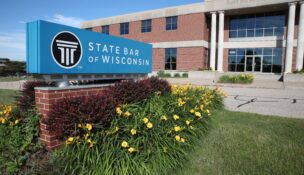CLOSING ARGUMENTS: Getting down to tax
By: WISCONSIN LAW JOURNAL STAFF//January 30, 2018//
Looking for a way to raise money for various road and building projects without raising the property tax levy, Brown County officials last year enacted an ordinance instituting a 0.5 percent local sales and use tax.
The $147 million that would be raised, they said, would be put to a new center for teaching science, technology and mathematics; museum exhibits; library improvements; and various other projects. Local officials warned that without the additional money, the county would be forced to borrow to pay for the same work.
It didn’t take long for the new tax to be met with a lawsuit. In a filing made on Jan. 3 on the behalf of the Brown County Taxpayers Association, the conservative-leaning Wisconsin Institute for Law & Liberty (WILL) argued that state law allows local sales taxes to be raised essentially for only one purpose: to lower property taxes.
By proposing to spend sales-tax revenue on capital projects, the suit alleges, Brown County officials are trying to exceed a state-imposed levy limit and are thus overstepping their authority.
WILL, on behalf of the Brown County Taxpayers Association, is asking a judge to place a temporary injunction on the tax while the merits of the case are being argued. Should the case go in their favor, their ultimate goal is to win a permanent injunction.
In this month’s Closing Arguments column, Tom Kamenick, deputy counsel at WILL, argues that Brown County’s new sales tax does not meet the requirements of state law because the tax was not intended to reduce the property tax levy and is, therefore, illegal.
Andrew Phillips, a lawyer at von Briesen & Roper retained to represent Brown County in this dispute, maintains conversely that county officials were acting within their rights.
Now, gentlemen, to your corners.
County proposing to use sales tax for wrong purpose
By Tom Kamenick
 By state law, local sales and use taxes “may be imposed only for the purpose of directly reducing the property tax levy.” Wis. Stat. § 77.70. The County Sales Tax is not directly reducing the property tax levy. It is therefore void and unenforceable.
By state law, local sales and use taxes “may be imposed only for the purpose of directly reducing the property tax levy.” Wis. Stat. § 77.70. The County Sales Tax is not directly reducing the property tax levy. It is therefore void and unenforceable.
Before 1985, counties could impose sales and use taxes, but the proceeds from such taxes were distributed instead to the municipalities within the county. In 1985, amid pressure to reduce property tax burdens, the Legislature allowed counties to use county sales tax proceeds themselves. Later that year, the Legislature took up a technical bill to improve tax administration and apply it to certain purchases (like vehicles) made outside the taxing county.
During the process, the Senate added language requiring the sales tax to be used “only for property tax relief,” which the Assembly replaced with “only for directly reducing the property tax levy.” The statute as it now reads requires a county to use the proceeds from a sales and use tax exclusively to reduce the amount of money it collects in property taxes (the property tax levy), not for new spending.
But Brown County is using the sales tax to pay for new spending instead of reducing its property tax levy. The tax is intended to fund $147 million in new spending, including infrastructure, roads, and facilities improvements, jail and mental health projects, library projects, an expo hall project, and other projects such as a STEM research center, park improvements, and museum exhibits. At the same time, Brown County’s tax levy is increasing from $86,661,972 in 2017 to $90,676,735 in 2018.
An opinion issued by then-Attorney General James Doyle in 1998 interpreted § 77.70 more broadly.
He concluded that preventing the property tax levy from rising had the same legal effect as reducing it. (No court has ever adopted that interpretation.) He reasoned that there was no meaningful distinction between using sales and use taxes to pay for existing expenses (lowering the actual property tax levy) or for new expenses (preventing the property tax levy from rising).
The Attorney General’s interpretation contradicts the plain language of the statute, which calls for a direct reduction, not the absence of an increase. The opinion also strains the meaning of “directly reducing the property tax levy,” because, at its best, preventing an increase in the property tax levy is an indirect method of relief. And the statute does not call merely for “relief” (direct or indirect). The Legislature specifically rejected that broader term, instead opting for more specific language requiring a direct reduction.
But even if the Attorney General’s opinion is a correct interpretation of Wis. Stat. § 77.70, Brown County’s sales tax is still unlawful. The Attorney General concluded that the term “directly” in the statute means that a sales tax cannot be used to pay for anything that the property tax levy could not be raised to pay for. Brown County’s sales tax does not meet that test, because Brown County could not have raised its property tax levy to pay for all the new spending being funded by the County Sales Tax. County levy limits, enacted seven years after the Attorney General opinion, establish how much counties may raise their property taxes, sharply limiting what a county can spend on new projects using a property tax increase or, according to the Attorney General’s reasoning, with a sales and use tax.
Because of levy limits, it is no longer true that a county can raise the property tax levy however much it wants to pay for new expenditures. It can only raise its levy by an amount proportional to the net growth in new construction in the county. If the cost of proposed projects exceeds the allowable levy increase, the county cannot raise its levy to pay for those projects. Because a county cannot raise its property tax levy to pay for those projects, enacting a sales and use tax to pay for those projects would not avoid a property tax increase that would otherwise occur.
Brown County proposes to pay for $147 million worth of new projects over seven years with its sales tax, including almost $18 million in new spending in 2018. Brown County’s allowable levy limit increase in 2018 was $4,453,035. Brown County therefore could not have raised its levy to pay for the $18 million in new projects. Although it could have exceeded its levy limits after a referendum or to pay for debt service on borrowing for the projects, it did not take either of those routes here.
Brown County is not using the sales tax “only for the purpose of directly reducing the property tax levy and only in [its] entirety.” Instead, Brown County is using the sales tax to evade its levy limits, increasing its tax revenue by more than 25 percent in 2018. Even under the Attorney General’s interpretation, the sales tax violates Wis. Stat. § 77.70.
We did not file this suit to argue about whether any of the planned projects are a good idea or about whether using a sales tax or a property tax is a better way to pay for projects county officials want to pursue. We went to court because the county cannot lawfully use the proceeds from its sales tax to pay for these new expenditures. It must use the proceeds to provide dollar-for-dollar property tax reductions.
Tom Kamenick is deputy counsel at the Wisconsin Institute for Law & Liberty specializing in open-government matters.
Plaintiffs missing the mark in several ways
By Andrew Phillips
I. INTRODUCTION
 The Plaintiffs’ lawsuit misses the mark from both a legal and policy perspective.
The Plaintiffs’ lawsuit misses the mark from both a legal and policy perspective.
The relevant statutes support Brown County’s imposition of the sales tax and the use of sales tax proceeds to offset the tremendous financing costs that Brown County would have incurred by borrowing funds necessary to complete critical building and infrastructure projects.
Moreover, it is difficult to understand how or why an association with a mission of promoting “limited government which is fiscally responsible” would promote a plan that places the entire burden of infrastructure and building upgrades and maintenance on the backs of property taxpayers rather than spreading part of that burden to visitors to Brown County, the vast majority of whom will use the infrastructure and buildings.
II. THE OPERATIVE STATUTE
The plaintiffs suggest that the statute governing Brown County’s use of sales tax proceeds, Wis. Stat. § 77.70, unequivocally mandates that Brown County apply sales tax proceeds received in 2018 to offset, dollar-for-dollar, the amount of property taxes Brown County levied in 2017. This analysis is simply incorrect.
Section 77.70 provides (in relevant part):
Any county desiring to impose county sales and use taxes under this subchapter may do so by the adoption of an ordinance, stating its purpose and referring to this subchapter. The rate of the tax imposed under this section is 0.5 percent of the sales price or purchase price. Except as provided in s. 66.0621 (3m) [which is irrelevant here] the county sales and use taxes may be imposed only for the purpose of directly reducing the property tax levy and only in their entirety as provided in this subchapter.
The plaintiffs claim that the calculation required by this statute is simple: the county’s 2017 property tax levy less the county’s anticipated revenue from the sales tax equals the county’s 2018 property tax levy.
This equation is indeed simple, but it is wrong. The plaintiffs fail to account for a county’s statutory authority to borrow funds for capital projects and place all debt service payments (principal and interest) on the property tax levy.
Once capital costs for building and infrastructure upgrades are considered, it is clear that Brown County is meeting both the letter and spirit of the statute. In other words, the correct equation to be applied here is: the county’s 2017 property tax levy plus amounts the county would have been required to levy for debt service on capital projects without a sales tax less the county’s anticipated revenue from the sales tax equals the County’s 2018 property tax levy.
And that is precisely what happened in this case – the county is using sales tax proceeds to offset, dollar-for-dollar, the amounts Brown County would otherwise have had to levy on Brown County taxpayers. Brown County’s actions in authorizing the sales tax and adopting its 2018 budget and property tax levy show that Brown County is using sales tax proceeds “for the purpose of directly reducing the property tax levy.”
III. THE POLICY JUSTIFICATIONS
Brown County is not the only Wisconsin county that has adopted the 0.5 percent sales tax. There are 65 other counties in the state that impose a sales tax.
There is no widespread acceptance of the plaintiffs’ proposed equation that would mandate a dollar-for-dollar offset of expected sales tax revenues from the previous year’s property tax levy. Indeed, the Department of Revenue, which is the state agency responsible for collecting property tax levy information from each county and determining compliance with state laws governing how much counties may impose as property taxes, has never required any county to follow the plaintiffs’ equation. It is clear that state and local officials from around the state have historically and consistently recognized that the plaintiffs’ equation is incorrect.
Beyond the universal acceptance shown by anybody and everybody who has been involved with the use of county sales tax revenues since the mid-1980s, the way that Brown County is using the proceeds in this instance makes perfect sense from a policy perspective.
Brown County’s plan cuts the county’s debt in half, by over $70 million. In addition, the plan saves approximately $40 million in interest costs over the 72-month duration of the sales tax.
But according to the plaintiffs, such cost savings, which inure to the direct benefit of the Brown County property taxpayer, are unlawful. Instead, the plaintiffs think Brown County should spend on a credit card and kick the costs of the debt tab down the road to both current and future property taxpayers. That analysis makes no sense and should be rejected.
IV. CONCLUSION
The plaintiffs are simply misguided in their legal and policy arguments in opposition to the sales tax. Brown County is indeed using sales tax revenues to offset its property tax levy. Moreover, it is clear that Brown County officials are doing everything in their power to respond to building and infrastructure needs in a prudent and responsible manner. For these reasons, and others that will be further discussed in the course of the litigation, the plaintiffs’ claims should be dismissed outright.
Andrew Phillips is a lawyer at von Briesen & Roper representing Brown County in this dispute.
Legal News
- State Bar leaders remain deeply divided over special purpose trust
- Former Wisconsin college chancellor fired over porn career is fighting to keep his faculty post
- Pecker says he pledged to be Trump campaign’s ‘eyes and ears’ during 2016 race
- A conservative quest to limit diversity programs gains momentum in states
- Wisconsin prison inmate pleads not guilty to killing cellmate
- Waukesha man sentenced to 30 years for Sex Trafficking
- 12-year-old shot in Milwaukee Wednesday with ‘serious injuries’
- Milwaukee man convicted of laundering proceeds of business email compromise fraud schemes
- Giuliani, Meadows among 18 indicted in Arizona fake electors case
- Some State Bar diversity participants walk away from program
- Wisconsin court issues arrest warrant ‘in error’ for Minocqua Brewing owner
- Iranian nationals charged cyber campaign targeting U.S. Companies
WLJ People
- Power 30 Personal Injury Attorneys – Russell Nicolet
- Power 30 Personal Injury Attorneys – Benjamin Nicolet
- Power 30 Personal Injury Attorneys – Dustin T. Woehl
- Power 30 Personal Injury Attorneys – Katherine Metzger
- Power 30 Personal Injury Attorneys – Joseph Ryan
- Power 30 Personal Injury Attorneys – James M. Ryan
- Power 30 Personal Injury Attorneys – Dana Wachs
- Power 30 Personal Injury Attorneys – Mark L. Thomsen
- Power 30 Personal Injury Attorneys – Matthew Lein
- Power 30 Personal Injury Attorneys – Jeffrey A. Pitman
- Power 30 Personal Injury Attorneys – William Pemberton
- Power 30 Personal Injury Attorneys – Howard S. Sicula











